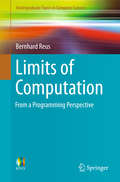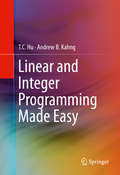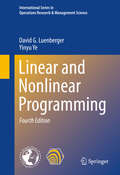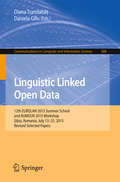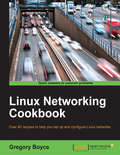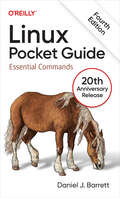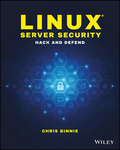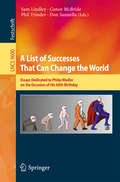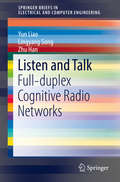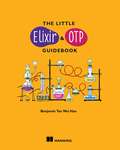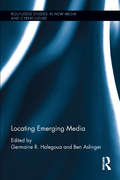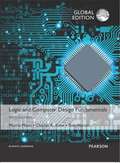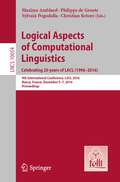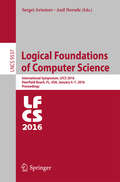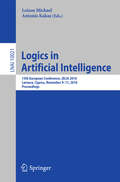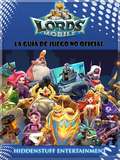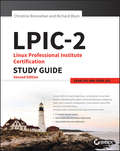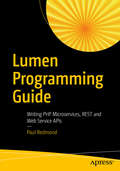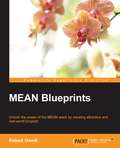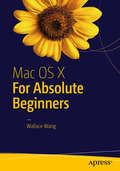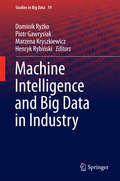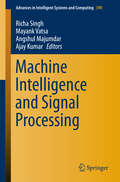- Table View
- List View
Limits of Computation
by Bernhard ReusThis textbook discusses the most fundamental and puzzling questions about the foundations of computing. In 23 lecture-sized chapters it provides an exciting tour through the most important results in the field of computability and time complexity, including the Halting Problem, Rice's Theorem, Kleene's Recursion Theorem, the Church-Turing Thesis, Hierarchy Theorems, and Cook-Levin's Theorem. Each chapter contains classroom-tested material, including examples and exercises. Links between adjacent chapters provide a coherent narrative. Fundamental results are explained lucidly by means of programs written in a simple, high-level imperative programming language, which only requires basic mathematical knowledge. Throughout the book, the impact of the presented results on the entire field of computer science is emphasised. Examples range from program analysis to networking, from database programming to popular games and puzzles. Numerous biographical footnotes about the famous scientists who developed the subject are also included. "Limits of Computation" offers a thorough, yet accessible, introduction to computability and complexity for the computer science student of the 21st century.
Linear and Integer Programming Made Easy
by T. C. Hu Andrew B. KahngThis textbook provides concise coverage of the basics of linear and integer programming which, with megatrends toward optimization, machine learning, big data, etc. , are becoming fundamental toolkits for data and information science and technology. The authors' approach is accessible to students from almost all fields of engineering, including operations research, statistics, machine learning, control system design, scheduling, formal verification and computer vision. The presentations enables the basis for numerous approaches to solving hard combinatorial optimization problems through randomization and approximation. Readers will learn to cast various problems that may arise in their research as optimization problems, understand the cases where the optimization problem will be linear, choose appropriate solution methods and interpret results appropriately.
Linear and Nonlinear Programming
by David G. Luenberger Yinyu YeThis new edition covers the central concepts of practical optimization techniques, with an emphasis on methods that are both state-of-the-art and popular. One major insight is the connection between the purely analytical character of an optimization problem and the behavior of algorithms used to solve a problem. This was a major theme of the first edition of this book and the fourth edition expands and further illustrates this relationship. As in the earlier editions, the material in this fourth edition is organized into three separate parts. Part I is a self-contained introduction to linear programming. The presentation in this part is fairly conventional, covering the main elements of the underlying theory of linear programming, many of the most effective numerical algorithms, and many of its important special applications. Part II, which is independent of Part I, covers the theory of unconstrained optimization, including both derivations of the appropriate optimality conditions and an introduction to basic algorithms. This part of the book explores the general properties of algorithms and defines various notions of convergence. Part III extends the concepts developed in the second part to constrained optimization problems. Except for a few isolated sections, this part is also independent of Part I. It is possible to go directly into Parts II and III omitting Part I, and, in fact, the book has been used in this way in many universities. New to this edition is a chapter devoted to Conic Linear Programming, a powerful generalization of Linear Programming. Indeed, many conic structures are possible and useful in a variety of applications. It must be recognized, however, that conic linear programming is an advanced topic, requiring special study. Another important topic is an accelerated steepest descent method that exhibits superior convergence properties, and for this reason, has become quite popular. The proof of the convergence property for both standard and accelerated steepest descent methods are presented in Chapter 8. As in previous editions, end-of-chapter exercises appear for all chapters. From the reviews of the Third Edition: ". . . this very well-written book is a classic textbook in Optimization. It should be present in the bookcase of each student, researcher, and specialist from the host of disciplines from which practical optimization applications are drawn. " (Jean-Jacques Strodiot, Zentralblatt MATH, Vol. 1207, 2011)
Linguistic Linked Open Data
by Diana Trandabăţ Daniela GîfuThis book constitutes therefereed proceedings of the 12th EUROLAN Summer School on Linguistic Linked Open Data and its Satellite Workshop on Social Media and the Web of Linked Data, RUMOUR 2015, held in Sibiu, Romania, in July 2015. The 10 revised full papers presented together with 12 abstracts of tutorials werecarefully reviewed and selected from 21 submissions.
Linux Networking Cookbook
by Gregory BoyceThis book is targeted at Linux systems administrators who have a good basic understanding and some prior experience of how a Linux machine operates, but want to better understand how various network services function, how to set them up, and how to secure them. You should be familiar with how to set up a Linux server and how to install additional software on them.
Linux Pocket Guide: Essential Commands
by Daniel J. BarrettIf you use Linux in your day-to-day work, then Linux Pocket Guide is the perfect on-the-job reference. This thoroughly updated 20th anniversary edition explains more than 200 Linux commands, including new commands for file handling, package management, version control, file format conversions, and more.In this concise guide, author Daniel Barrett provides the most useful Linux commands grouped by functionality. Whether you're a novice or an experienced user, this practical book is an ideal reference for the most important Linux commands.You'll learn:Essential concepts—commands, shells, users, and the filesystemFile commands-creating, organizing, manipulating, and processing files of all kindsSysadmin basics-superusers, processes, user management, and software installationFilesystem maintenance-disks, RAID, logical volumes, backups, and moreNetworking commands-working with hosts, network connections, email, and the webGetting stuff done-everything from math to version control to graphics and audio
Linux Server Security: Hack and Defend
by Chris BinnieLearn how to attack and defend the world’s most popular web server platform Linux Server Security: Hack and Defend presents a detailed guide for experienced admins, aspiring hackers and other IT professionals seeking a more advanced understanding of Linux security. Written by a 20-year veteran of Linux server deployment this book provides the insight of experience along with highly practical instruction. The topics range from the theory of past, current, and future attacks, to the mitigation of a variety of online attacks, all the way to empowering you to perform numerous malicious attacks yourself (in the hope that you will learn how to defend against them). By increasing your understanding of a hacker’s tools and mindset you're less likely to be confronted by the all-too-common reality faced by many admins these days: someone else has control of your systems. Master hacking tools and launch sophisticated attacks: perform SQL injections, deploy multiple server exploits and crack complex passwords. Defend systems and networks: make your servers invisible, be confident of your security with penetration testing and repel unwelcome attackers. Increase your background knowledge of attacks on systems and networks and improve all-important practical skills required to secure any Linux server. The techniques presented apply to almost all Linux distributions including the many Debian and Red Hat derivatives and some other Unix-type systems. Further your career with this intriguing, deeply insightful, must-have technical book. Diverse, broadly-applicable and hands-on practical, Linux Server Security: Hack and Defend is an essential resource which will sit proudly on any techie's bookshelf.
A List of Successes That Can Change the World: Essays Dedicated to Philip Wadler on the Occasion of His 60th Birthday (Lecture Notes in Computer Science #9600)
by Sam Lindley Conor Mcbride Phil Trinder Don SannellaThis volume is published in Honor of PhilipWadler on the occasion of his 60th birthday, and the collection of papers forma Festschrift for him. The contributions are made by some of the many who knowPhil and have been influenced by him. The research papers included hererepresent some of the areas in which Phil has been active, and the editorsthank their colleagues for agreeing to contribute to this Festschrift. We attemptto summarize Phil Wadler's scientific achievements. In addition, we describethe personal style and enthusiasm that Phil has brought to the subject.
Listen and Talk
by Yun Liao Lingyang Song Zhu HanThis brief focuses on the use of full-duplex radio in cognitive radio networks, presenting a novel spectrum sharing protocol that allows the secondary users to simultaneously sense and access the vacant spectrum. This protocol, called "Listen-and-talk" (LAT), is evaluated by both mathematical analysis and computer simulations in comparison with other existing protocols, including the listen-before-talk protocol. In addition to LAT-based signal processing and resource allocation, the brief discusses techniques such as spectrum sensing and dynamic spectrum access. The brief proposes LAT as a suitable access scheme for cognitive radio networks, which can support the quality-of-service requirements of these high priority applications. Fundamental theories and key techniques of cognitive radio networks are also covered. Listen and Talk: Full-duplex Cognitive Radio Networks is designed for researchers, developers, and professionals involved in cognitive radio networks. Advanced-level students studying signal processing or simulations will also find the content helpful since it moves beyond traditional cognitive radio networks into future applications for the technology.
Literature in the Digital Age
by Adam HammondLiterature in a Digital Age: An Introduction guides readers through the most salient theoretical, interpretive, and creative possibilities opened up by the shift to digital literary forms such as e-books, digital archives, and electronic literature. While Digital Humanities (DH) has been hailed as the 'next big thing' in literary studies, many students and scholars remain perplexed as to what a DH approach to literature entails, and skeptical observers continue to see literature and the digital world as fundamentally incompatible. In its argument that digital and traditional scholarship should be placed in dialogue with each other, this book contextualizes the advent of the digital in literary theory, explores the new questions readers can ask of texts when they become digitized, and investigates the challenges that fresh forms of born-digital fiction pose to existing models of literary analysis.
The Little Elixir & OTP Guidebook
by Benjamin Tan Wei HaoSummaryThe Little Elixir & OTP Guidebook gets you started programming applications with Elixir and OTP. You begin with a quick overview of the Elixir language syntax, along with just enough functional programming to use it effectively. Then, you'll dive straight into OTP and learn how it helps you build scalable, fault-tolerant and distributed applications through several fun examples. Purchase of the print book includes a free eBook in PDF, Kindle, and ePub formats from Manning Publications.About the TechnologyElixir is an elegant programming language that combines the expressiveness of Ruby with the concurrency and fault-tolerance of Erlang. It makes full use of Erlang's BEAM VM and OTP library, so you get two decades' worth of maturity and reliability right out of the gate. Elixir's support for functional programming makes it perfect for modern event-driven applications.About the BookThe Little Elixir & OTP Guidebook gets you started writing applications with Elixir and OTP. You'll begin with the immediately comfortable Elixir language syntax, along with just enough functional programming to use it effectively. Then, you'll dive straight into several lighthearted examples that teach you to take advantage of the incredible functionality built into the OTP library. What's InsideCovers Elixir 1.2 and 1.3Introduction to functional concurrency with actorsExperience the awesome power of Erlang and OTP About the ReaderWritten for readers comfortable with a standard programming language like Ruby, Java, or Python. FP experience is helpful but not required. About the AuthorBenjamin Tan Wei Hao is a software engineer at Pivotal Labs, Singapore. He is also an author, a speaker, and an early adopter of Elixir.Table of ContentsGETTING STARTED WITH ELIXIR AND OTPIntroduction A whirlwind tour Processes 101 Writing server applications with GenServer FAULT TOLERANCE, SUPERVISION, AND DISTRIBUTION Concurrent error-handling and fault tolerance with links, monitors, and processes Fault tolerance with Supervisors Completing the worker-pool application Distribution and load balancing Distribution and fault tolerance Dialyzer and type specifications Property-based and concurrency testing
Locating Emerging Media (Routledge Studies in New Media and Cyberculture)
by Ben Aslinger Germaine R. HalegouaLocating Emerging Media focuses on the tensions between the local and global in the design, distribution, and use of emerging media forms, building on scholarship on the cultural geography of new media networks and products and the relationships between the "global" and the "local." Authors consider new media practices, texts, services, software, policies, infrastructures, and design discourses that enrich existing relationships between creative industries and cultures of production, reception, and engagement. This consideration highlights the relationships between global and local perspectives and new media technologies and practices emerging within (and through) the geography and culture of particular places. Areas examined include East Asia, Latin America, Africa, Europe, South Asia, the Pacific Islands, and the Middle East. Through all is the recognition that what is new or emergent around the globe is unique in each locality.
Logic and Algebraic Structures in Quantum Computing
by Jennifer Chubb Ali Eskandarian Valentina HarizanovArising from a special session held at the 2010 North American Annual Meeting of the Association for Symbolic Logic, this volume is an international cross-disciplinary collaboration with contributions from leading experts exploring connections across their respective fields. <P><P>Themes range from philosophical examination of the foundations of physics and quantum logic, to exploitations of the methods and structures of operator theory, category theory, and knot theory in an effort to gain insight into the fundamental questions in quantum theory and logic. The book will appeal to researchers and students working in related fields, including logicians, mathematicians, computer scientists, and physicists. A brief introduction provides essential background on quantum mechanics and category theory, which, together with a thematic selection of articles, may also serve as the basic material for a graduate course or seminar.
Logic and Computer Design Fundamentals
by Charles R. Kime Tom Martin M. Morris ManoFor courses in Logic and Computer design. Understanding Logic and Computer Design for All Audiences Logic and Computer Design Fundamentals is a thoroughly up-to-date text that makes logic design, digital system design, and computer design available to students of all levels. The Fifth Edition brings this widely recognized source to modern standards by ensuring that all information is relevant and contemporary. The material focuses on industry trends and successfully bridges the gap between the much higher levels of abstraction students in the field must work with today than in the past. Broadly covering logic and computer design, Logic and Computer Design Fundamentals is a flexibly organized source material that allows instructors to tailor its use to a wide range of student audiences.
Logical Aspects of Computational Linguistics. Celebrating 20 Years of LACL: 9th International Conference, LACL 2016, Nancy, France, December 5-7, 2016, Proceedings (Lecture Notes in Computer Science #10054)
by Maxime Amblard Philippe De Groote Sylvain Pogodalla Christian RetoréEdited under the auspices of the Association of Logic, Language andInformation (FoLLI), this book constitutes the refereed proceedings ofthe 20th anniversary of the International Conference on LogicalAspects of Computational Linguistics, LACL 2016, held in LORIA Nancy,France, in December 2016. The 19 contributed papers, presentedtogether with 4 invited papers and 6 abstracts, were carefullyreviewed and selected from 38 submissions. The focus of the conferenceis the use of type theoretic, proof theoretic, and model theoreticmethods for describing and formalising natural language syntax,semantics, and pragmatics as well as the implementation of thecorresponding tools.
Logical Aspects of Computational Linguistics. Celebrating 20 Years of LACL (1996–2016)
by Maxime Amblard Philippe Groote Sylvain Pogodalla Christian RetoréEdited under the auspices of the Association of Logic, Language and Information (FoLLI), this book constitutes the refereed proceedings of the 20th anniversary of the International Conference on Logical Aspects of Computational Linguistics, LACL 2016, held in LORIA Nancy, France, in December 2016. The 19 contributed papers, presented together with 4 invited papers and 6 abstracts, were carefully reviewed and selected from 38 submissions. The focus of the conference is the use of type theoretic, proof theoretic, and model theoretic methods for describing and formalising natural language syntax, semantics, and pragmatics as well as the implementation of the corresponding tools.
Logical Foundations of Computer Science
by Anil Nerode Sergei ArtemovThis bookconstitutes the refereed proceedings of the International Symposium on LogicalFoundations of Computer Science, LFCS 2016, held in Deerfield Beach, FL, USA inJanuary 2016. The 27 revised full paperswere carefully reviewed and selected from 46 submissions. The scopeof the Symposium is broad and includes constructive mathematics and typetheory; homotopy type theory; logic, automata, and automatic structures;computability and randomness; logical foundations of programming; logicalaspects of computational complexity; parameterized complexity; logicprogramming and constraints; automated deduction and interactive theoremproving; logical methods in protocol and program verification; logical methodsin program specification and extraction; domain theory logics; logicalfoundations of database theory; equational logic and term rewriting; lambda andcombinatory calculi; categorical logic and topological semantics; linear logic;epistemic and temporal logics; intelligent and multiple-agent system logics;logics of proof and justification; non-monotonic reasoning; logic in gametheory and social software; logic of hybrid systems; distributed system logics;mathematical fuzzy logic; system design logics; and other logics in computerscience.
Logics in Artificial Intelligence
by Loizos Michael Antonis KakasThis book constitutes the proceedings of the 15th European Conference on Logics in Artificial Intelligence, JELIA 2016, held in Larnaca, Cyprus, in November 2015. The 32 full papers and 10 short papers included in this volume were carefully reviewed and selected from 88 submissions. The accepted papers span a number of areas within Logics in AI, including: belief revision, answer set programming, argumentation, probabilistic reasoning, handling inconsistencies, temporal logics and planning, description logics, and decidability and complexity results.
Lords Mobile: La guía de juego no oficial
by Hiddenstuff Entertainment Carlos SalasDescripción del libro: *GUÍA NO OFICIAL* Consejos avanzados y guía de estrategias. Esta es la guía más comprensible y detallada que podrás encontrar en línea. Disponible para su descarga en teléfono celular, lector de libros electrónicos o en formato físico. Con el éxito de mis cientos de guías y estrategias, he escrito otra guía avanzada profesional para todos los jugadores. Esta te ofrece estrategias específicas de como progresar en el juego, derrotar a tus oponentes, obtener más monedas y mucho más. - Consejos y estrategias profesionales. - Trucos y hacks. - Secretos, consejos, trucos, desbloqueos y trucos utilizados por jugadores profesionales. - Obtener mucho dinero/monedas. - ¡Y MUCHO MÁS! Todas las versiones de esta guía tienen capturas de pantalla que te ayudarán a entender mejor el juego. No hay ninguna otra guía que sea tan comprensible y avanzada como esta. Aviso legal: Este producto no está asociado, afiliado, promocionado o patrocinado por los derechos de autor original del dueño.
LPIC-2: Exam 201 and Exam 202
by Christine Bresnahan Richard BlumFull coverage of the latest LPI-level 2 exams, with bonus online test bank LPIC-2 is the one-stop preparation resource for the Linux Professional Institute's Advanced Level certification exam. With 100 percent coverage of all exam objectives, this book provides clear and concise coverage of the Linux administration topics you'll need to know for exams 201 and 202. Practical examples highlight the real-world applications of important concepts, and together, the author team provides insights based on almost fifty years in the IT industry. This brand new second edition has been completely revamped to align with the latest versions of the exams, with authoritative coverage of the Linux kernel, system startup, advanced storage, network configuration, system maintenance, web services, security, troubleshooting, and more. You also get access to online learning tools including electronic flashcards, chapter tests, practice exams, and a glossary of critical terms to help you solidify your understanding of upper-level Linux administration topics. The LPI-level 2 certification confirms your advanced Linux skill set, and the demand for qualified professionals continues to grow. This book gives you the conceptual guidance and hands-on practice you need to pass the exam with flying colors. Understand all of the material for both LPIC-2 exams Gain insight into real-world applications Test your knowledge with chapter tests and practice exams Access online study aids for more thorough preparation Organizations are flocking to the open-source Linux as an excellent, low-cost, secure alternative to expensive operating systems like Microsoft Windows. As the Linux market share continues to climb, organizations are scrambling to find network and server administrators with expert Linux knowledge and highly practical skills. The LPI-level 2 certification makes you the professional they need, and LPIC-2 is your ideal guide to getting there.
Lumen Programming Guide
by Paul RedmondLearn to write test-driven microservices, REST APIs, and web service APIs with PHP using the Lumen micro-framework, from the now popular Laravel family. This book shows you how testing APIs can help you write bullet-proof web application services and microservices. In the Lumen Programming Guide you will learn how to use Lumen—a micro-framework by Laravel—to write bullet-proof APIs. Lumen helps you write productive, maintainable APIs using modern application design. You will learn how to write fully-tested APIs and understand essential Lumen concepts used to build a solid foundation for writing API projects.What You Will LearnMaintain your API's database structure through built-in database migrationsWrite tests with factory data in a test databaseRespond with consistent data output in JSONDeal with PHP exceptions by using JSON responsesCreate, read, update, and delete REST resourcesRepresent model associations in API responsesBuild a solid foundation for writing tests with PHPUnit and MockeryValidate data Who This Book Is ForPHP developers with no Laravel experience. Only a basic understanding of HTTP and writing PHP applications is needed to get started.
M.E.A.N. Blueprints
by Robert OnodiIf you are a web developer with a basic understanding of the MEAN stack, experience in developing applications with JavaScript, and basic experience with NoSQL databases, then this book is for you.
Mac OS X for Absolute Beginners
by Wallace WangBest-selling author Wallace Wang teaches you how to use El Capitan, the latest version of the Mac operating system, in everyday situations. This book shows you, the beginner Mac user, how to get up and running, operate, and work day-to-day on your Mac. You will learn how to run applications, manage windows and files, work with the internet, and more. You will even learn how to use your Mac with an iPhone and an Apple watch. If you've ever felt that you couldn't learn how to use a Mac, this is your opportunity to give it a go. What you'll learn How to get up and running with Mac OS X El Capitan How to navigate and manage views How to manage your files What entertainment options are available to you, and how to use them How to maintain your Mac How to work with iPhone and Apple watch. Who this book is for Anyone who wants to learn how to use OS X El Capitan. No previous experience is required.
Machine Intelligence and Big Data in Industry
by Dominik Ryżko Piotr Gawrysiak Marzena Kryszkiewicz Henryk RybińskiThis book presents valuable contributions devoted topractical applications of Machine Intelligence and Big Data in various branchesof the industry. All the contributions are extended versions of presentationsdelivered at the Industrial Session the 6th International Conference on PatternRecognition and Machine Intelligence (PREMI 2015) held in Warsaw, Poland atJune 30- July 3, 2015, which passed through a rigorous reviewing process. Thecontributions address real world problems and show innovative solutions used tosolve them. This volume will serve as a bridge between researchers andpractitioners, as well as between different industry branches, which can benefitfrom sharing ideas and results.
Machine Intelligence and Signal Processing
by Richa Singh Mayank Vatsa Angshul Majumdar Ajay KumarThis book comprises chapters on key problems in machine learning and signal processing arenas. The contents of the book are a result of a 2014 Workshop on Machine Intelligence and Signal Processing held at the Indraprastha Institute of Information Technology. Traditionally, signal processing and machine learning were considered to be separate areas of research. However in recent times the two communities are getting closer. In a very abstract fashion, signal processing is the study of operator design. The contributions of signal processing had been to device operators for restoration, compression, etc. Applied Mathematicians were more interested in operator analysis. Nowadays signal processing research is gravitating towards operator learning - instead of designing operators based on heuristics (for example wavelets), the trend is to learn these operators (for example dictionary learning). And thus, the gap between signal processing and machine learning is fast converging. The 2014 Workshop on Machine Intelligence and Signal Processing was one of the few unique events that are focused on the convergence of the two fields. The book is comprised of chapters based on the top presentations at the workshop. This book has three chapters on various topics of biometrics - two are on face detection and one on iris recognition; all from top researchers in their field. There are four chapters on different biomedical signal / image processing problems. Two of these are on retinal vessel classification and extraction; one on biomedical signal acquisition and the fourth one on region detection. There are three chapters on data analysis - a topic gaining immense popularity in industry and academia. One of these shows a novel use of compressed sensing in missing sales data interpolation. Another chapter is on spam detection and the third one is on simple one-shot movie rating prediction. Four other chapters cover various cutting edge miscellaneous topics on character recognition, software effort prediction, speech recognition and non-linear sparse recovery. The contents of this book will prove useful to researchers, professionals and students in the domains of machine learning and signal processing.
